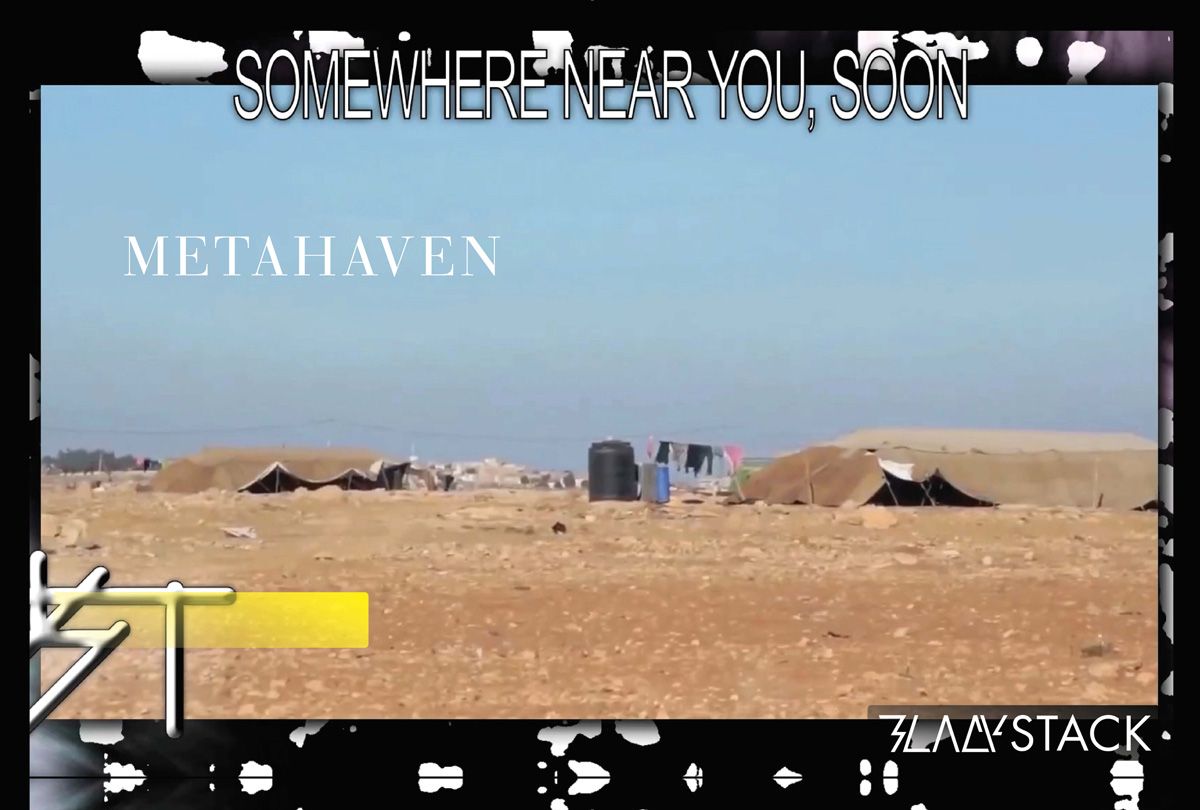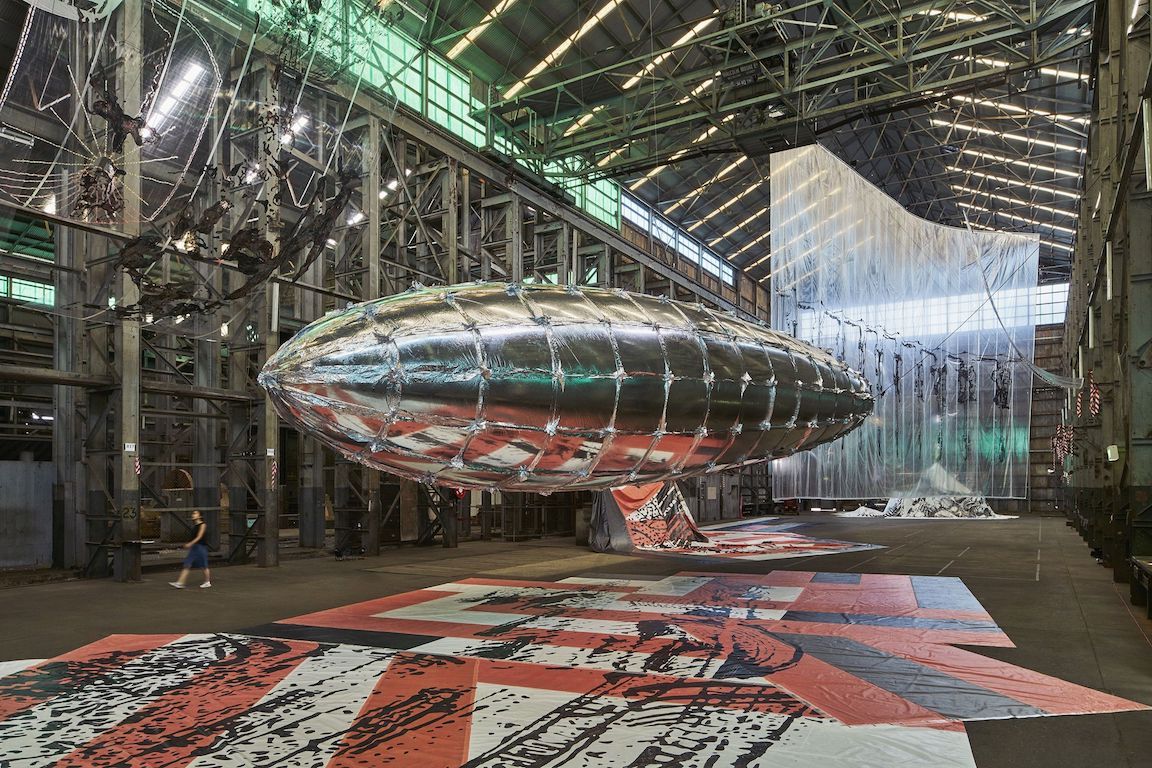METAHAVEN: Version History at the London Institute of Contemporary Arts
|William Alderwick
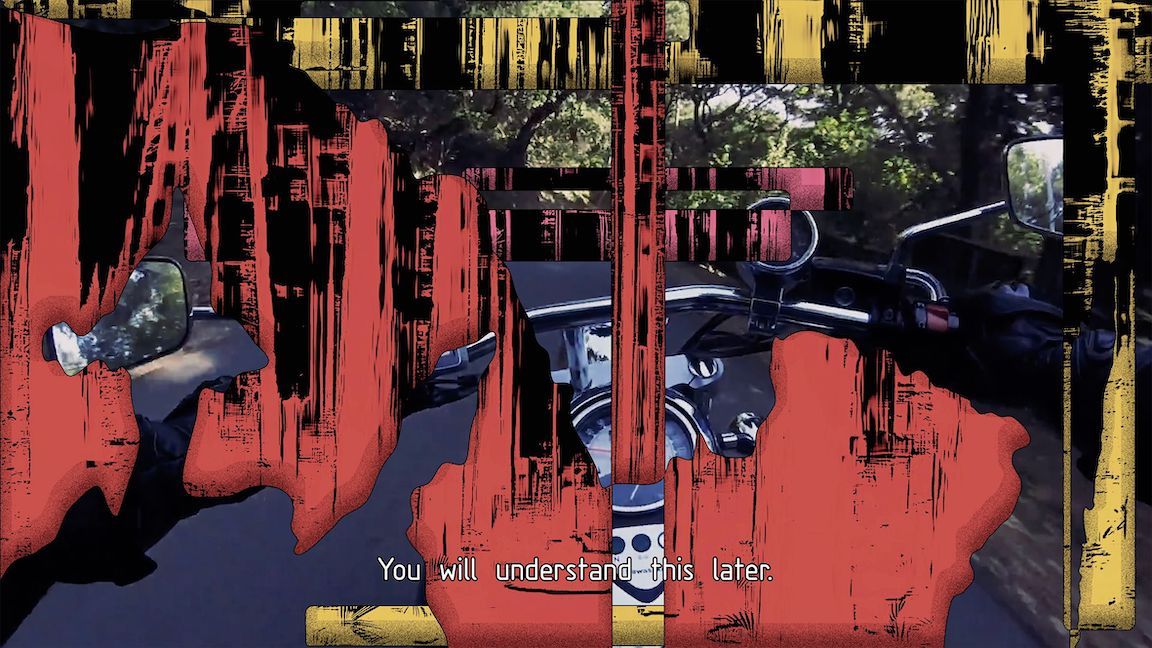
A train rolls languidly through open plains, slowly bending out of the distance, following the rails arching right, curved easterly. There’s almost no movement. It’s a long lingering shot, patiently waiting for something to arrive: freight carried along the New Silk Road.
Eurasia (Questions on Happiness) plays on a 16-screen video grid stacked on a carpeted stage, opposite the banked steps of the main gallery inside London’s Institute of Contemporary Arts. There’s something of a derelict cinema or post-riot feel to Version History, the installation which houses art-design collective Metahaven’s latest film. Graphic murals of exposed brickwork, shattered glass, and crowd control barriers frame the screen, spreading across the ICA’s already bare, chipped plaster walls.
Comprised of Daniel van der Velden and Vinca Kruk, Metahaven has pursued its
multifaceted, research-driven practice for nearly 15 years. From early design work for former North Sea data-haven Sealand, and the playful merchandising of Wikileaks with leak-commemorating t-shirts, Metahaven’s output has incorporated graphic design, music videos, visual identities, essays, books, talks, policy initiatives, teaching and more. Their books have taken aim at nation-state branding (Uncorporate Identity, 2010) and theorized a new subversive logic of representation, informational transparency and data activism (Black Transparency, 2015). Within a digitally maximalist and multilayered visual aesthetic, their work exposes and critiques the political and technological infrastructures that shape the digital landscapes in which we increasingly spend our time.
Since 2015, the collective has been moving towards film as a primary medium. Their first feature-length, The Sprawl: Propaganda about Propaganda (2015), was a rich documentary video essay that mixed found footage, anime, graphics, and talking heads. The Sprawl explored the affective space of psy-ops, propaganda, and mass communications. In order to address the weaponization of the internet, it presented fake news within the context of the global computational megastructures out of which it emerges. Shown online as a randomly sequenced series of short, minute-long snippets, the film pulled together a host of random threads to mimic or reflect media at the height of the infowars – a world where conspiracy theories seemingly became the base unit of siloed reality.
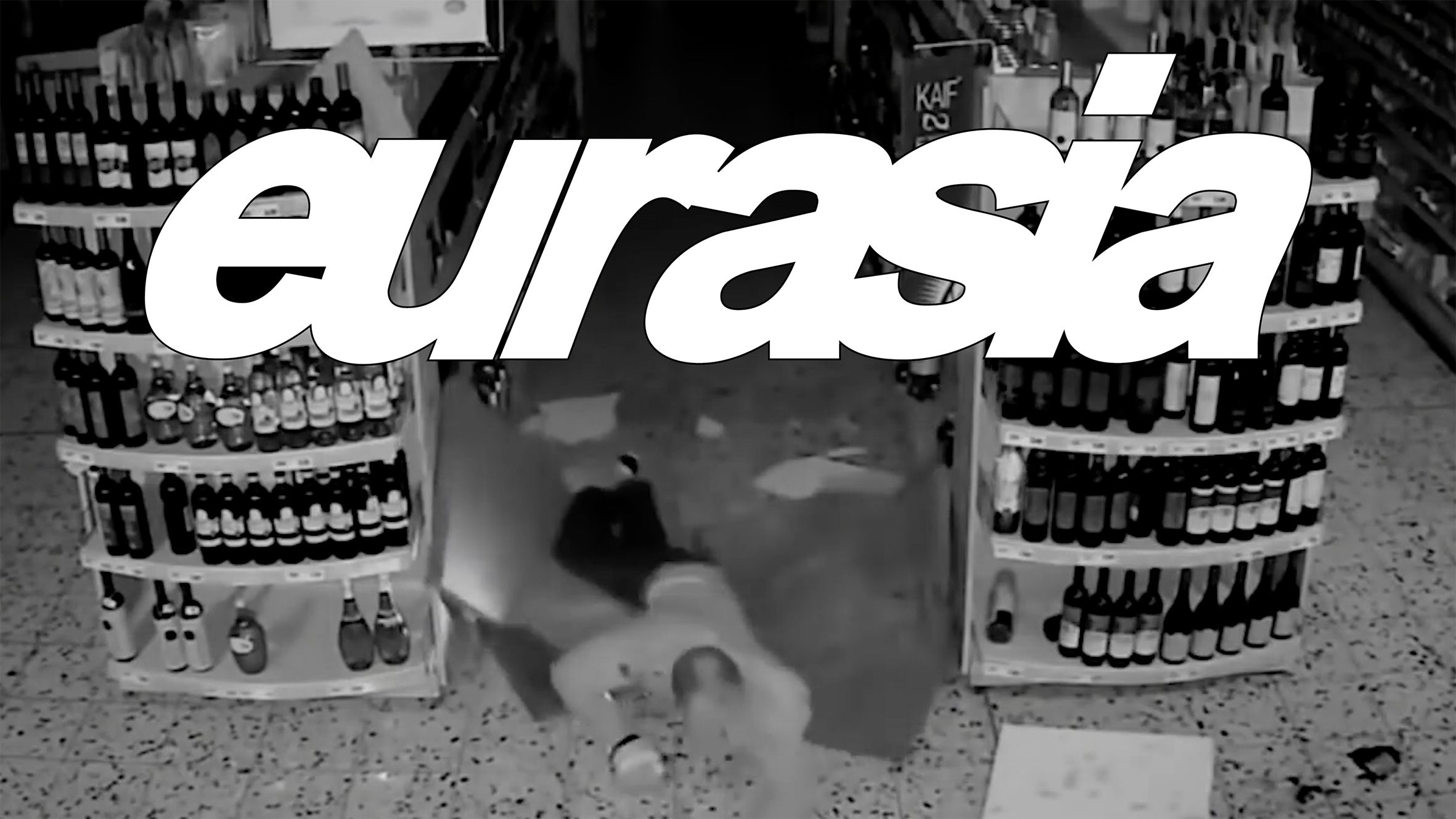
Inspired by Benjamin H. Bratton’s The Stack, the concern with computational megastructures goes beyond the prevalence of screens and toward the undersides and unseen: the infrastructures, depots, transit routes – the physical remainders, and those left behind. Eurasia visits the town of Veles in Macedonia, made famous in 2016 when local teenagers began making money using Google AdSense running fake news sites inventing and promoting conspiracies that targeted the US election. If there’s a certain sympathy for the enterprising youth as victims and scapegoats of a system that rewards and reinforces their behaviors it’s because their condition reflects our own. At a turning point in the film, an Asian actor stands on a mountain of industrial slag outside Veles contemplating this world – a cypher for both ourselves and the Macedonian teens like a last man gazing upon an epistemologically war-torn landscape.
It is against this backdrop that Eurasia goes in search of the New Silk Road: Chinese premier Xi Jinping’s multi-billion dollar global trade infrastructure initiative to link East and West. Part autistic travelogue through the Urals and Macedonia, part AI-dreamscape, and part cinematic essay, the film winds along the crossroads of continents and civilizations within the broader context of awakening AI on a global computational scale. Found footage woven into this journey includes Italian comic-turned-populist Beppe Grillo telling jokes in the European Parliament, Eurasian ontologies by Russian far-right ideologue Aleksandr Dugin, and the tragi-comic figure of an impassioned Chinese entrepreneur lauding his company’s world changing creative innovations in the novelty plastic straw market. These disparate threads trace the outlines of the various worldviews etched into the ground with imaginary lines, fences, borders and tracks. Near its opening, the film visits a Russian monument styled like a miniature Eiffel Tower marking the line dividing Europe and Asia; an imaginary point where two worlds meet. They touch. In another scene, a golden coin imprinted with the same monument spins on a mirror, slowly rotating closer and closer to its reflection until they rest together as one.
Version History, a sister show to the collective’s first major museum survey EARTH, currently showing at the Stedelijk Museum in Amsterdam, also includes films Information Skies (2016) and Hometown (2018), as well as Digital Tarkovsky (2018), an essay on cinematic time given at Strelka Institute in Moscow and displayed slowly scrolling on vertical screens in the ICA canteen. The exhibition title Version History suggests the idea that old situations or ways of being can be stored and reverted to – like a backup. In one clip, Dutch politician Frans Timmermans bemoans the nationalism sweeping Europe as selling a future based on a past that never existed. In another, a citation from Durkheim muses that truth cannot be immutable because reality is not immutable, so truth itself must be changeable. As ICA chief curator Richard Birkett noted at the press preview, the name also implies an imperative: to version history yourself, own and construct, or rather re-construct, your own histories. It’s as if the victors of the future are rewriting the present to be their past – with the somewhat ominous implication that the post-truth infowars are only just beginning.
It is noteworthy that in establishing Black Transparency’s subversive logic of non-representation, Metahaven place an emphasis on the emotional component – the empathic. Their design is not solely about communicating an idea so much as about how it makes one feel. This concern also runs through their fictional films Information Skies and Hometown. These are less stories you’re told, than stories you feel. Abstracted, weaving across textural layers and narrative registers, they echo the emotive lives and self-conceptions of their characters as stories whose arc you intuit and read into the films. A continuum runs from Metahaven’s early graphic works through the operational and affective space of psy-ops. Their work could be read as an investigation into this space, its ever-changing rules, and the fantasy realities that structure it.
The collective’s textural play doesn’t only mix iPhone, found and cinematic film stocks sequentially one texture next to another, but also what the collective terms “interfacial ruins” – defunct digital elements that float over shots as if pulled from some obsolete visual interface. In Information Skies, together with Metahaven’s own anime animations, they signal sequences set in a VR dream world where the film’s central couple take refuge. In Eurasia, this interface improvisation includes sequences with reflective golden plates or CDs printed with unfamiliar geographic shapes that recall the generic loading sequences of an out-of-region DVD. In other interstitial moments, a gold ouroboros spins like a futuristic buffering icon or a golden YouTube timeline at the base of the screen, running backwards, scrubbing through time to a prior version or scene.
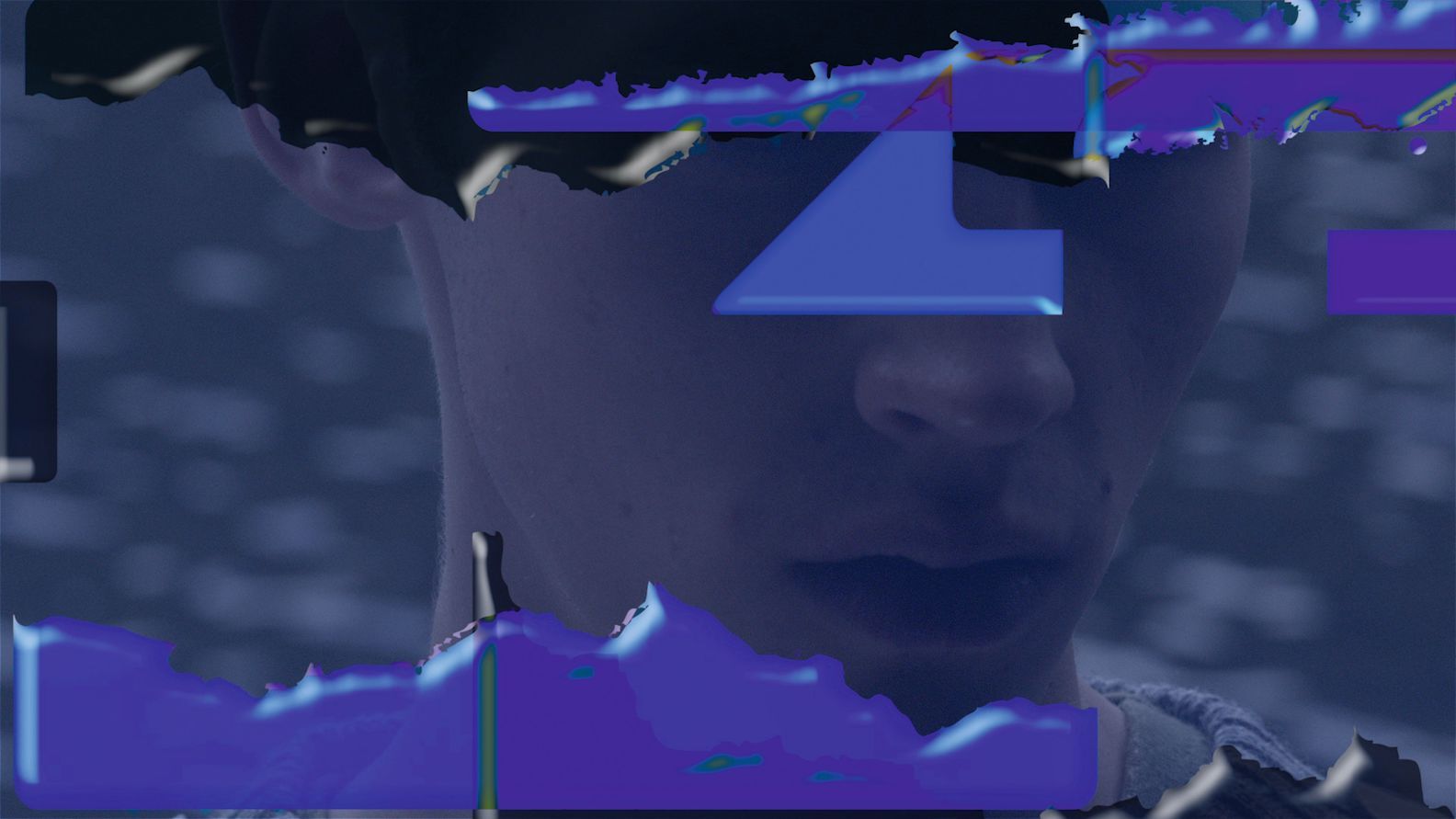
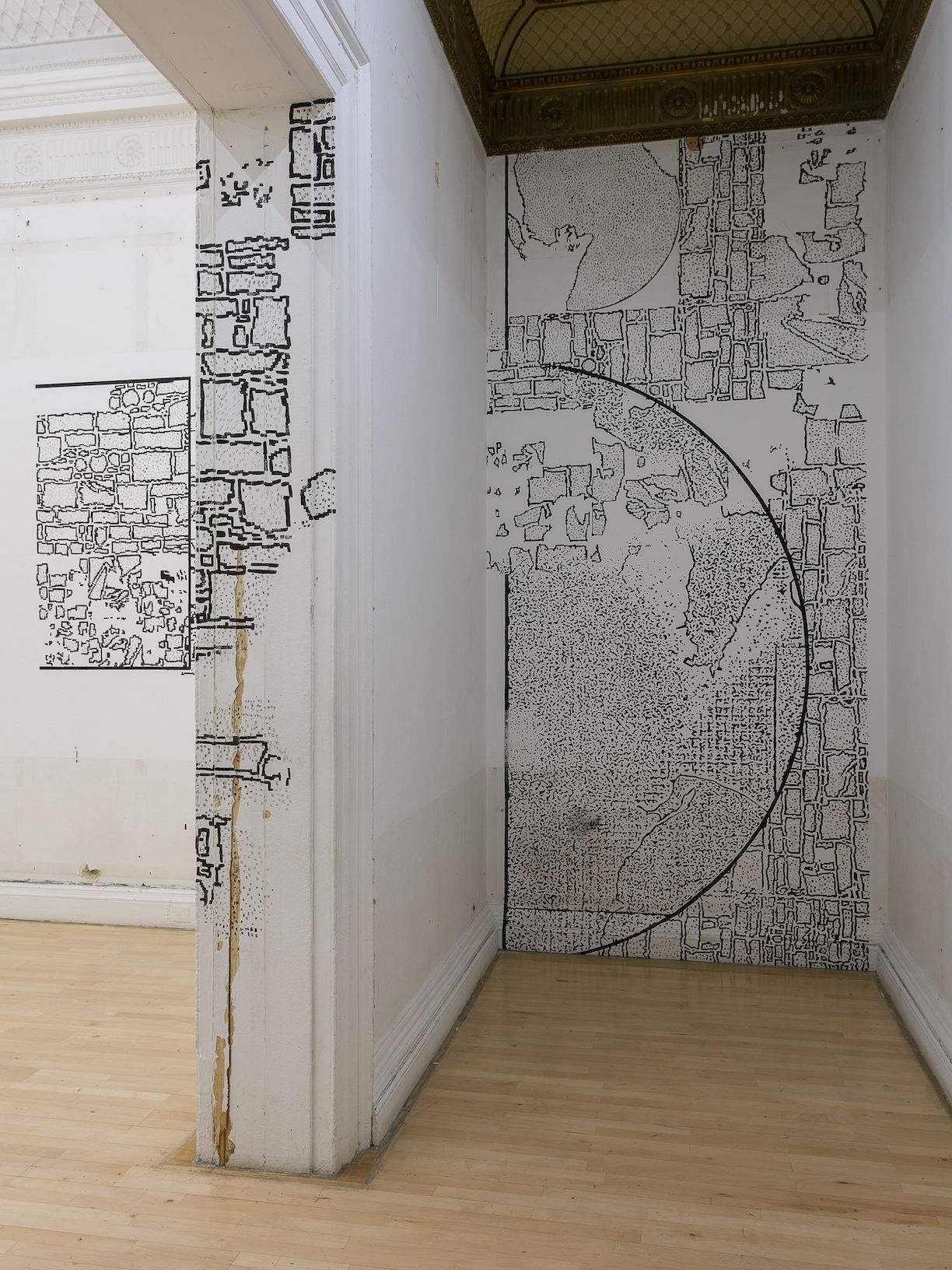
In many ways, more than any of the collective’s other films, Eurasia is a film about land. The earth, ground, soil, landscapes feature unfiltered, unencumbered by a frame, filter or interface. The camera lingers on its scene, indifferent to what is within its frame, nothing happening but the place. Train tracks curve past abandoned buildings, industrial wastelands pass into plains and rolling hills. In perhaps the film’s centerpiece, a series of long contemplative shots stretch out across the Russian plains toward the horizon and an immense dramatic sky above. Fade into a stunningly beautiful sun setting on the horizon with the golden fluffs of grass heads haloed in the shadows as booming, brooding drones reverberate. This Tarkovsky-inspired “longue durée,” over three minutes in length, produces a moment of stillness that soaks into the viewer. This is land as character – maybe even as the protagonist of the story. After the sun sets, a drone circles a static camera standing on a peak, two machines gazing into each other's lenses.
If the eye is the window to the soul then what does a camera lens open onto? In this barren moment, emptied of man, Eurasia returns to a second nature. We cut to immersive CGI footage showing a war-torn steppe landscape so realistic as to be easily mistaken as filmed. Taken from a Ukrainian video game called S.T.A.L.K.E.R. (Shadow of Chernobyl), the clip shows a sci-fi fantasy soldier walking through the rendered space, picking up and carrying away a fallen comrade. This is an implicit Tarkovsky homage, according to Metahaven, his Stalker protagonist making a cameo appearance in their film. Through this Eurasia becomes the Zone, a site of extraterrestrial incursion forever mystically and magically transfigured by it. The rescue here juxtaposes with one of the first clips in the film, in which a Russian TV presenter decries the decadent eschatology of Lars von Trier, pathologically linked to Trier’s fear of flying. In contrast to almost all other storytellers of world-ending disaster, von Trier offers no savior, and no rescue. As such perhaps, for Metahaven, we are the Zone or Eurasia’s extraterrestrials, and the question is how is this site, this land, transfigured by our incursions and subsequent absence? The re-natured environment is virtual, awakened, alive – and the ultimate horizon of Eurasia opens out beyond east meets west.
This beating heart of the film is poetic. In between citations from Durkheim and Kissinger, the film flows through readings of poems by three Russian poets: “I know the truth” by Marina Tsvetaeva, “Silentium!” by Fyodor Tyutchev, and “Snow Lies” by Alexander Vvedensky. These emotional abstracts structure the film and open out space in between its elements to intuit a feeling, a mood. They carry us towards an emotional connection or empathic sensitivity for what it is like to be alive in there, and to inhabit this world. A recurrent device in the film sees a landscape shot slowly rotate, from horizontal to vertical. This losing of the horizon – or acquiring a “vorizon,” a vertical horizon at the disappearing perspectival edge(s) between objects — brings our last man face to face with the ground, with Eurasia.
This interface returns us to the film’s subtitle, Questions on Happiness. What are these questions that are never explicitly asked? Is Eurasia itself the question, that it is or could bring happiness? This would be Eurasia as a promise, as a land of spiritual reunification and reconciliation, with the oneness of the globe hidden within these steppes, Europe and Asia coming together. Yet the film never explicitly engages with happiness. There is a nostalgic, sentimental longing to it, a pervading sadness, even melancholy in the “longue durée” contemplative views of the steppes. Ultimately, perhaps Metahaven suggest that even happiness itself and the desire for it is a fantasy, and both the world itself, and any AI regurgitation of it will be bluntly indifferent to our dreams and fantasies.
Another reading entirely sees Eurasia as farce. The title sequence plays out over blooper-style found footage of young people falling through supermarket ceilings, warehouse shelving units toppling like dominoes, and a tank tipping off the side of a ramp, scuttled like an upside-down beetle. Certainly Metahaven bring a self-reflexive humor to bear on their own work. Eurasia’s audio-visual climax is a stirring music video sequence comically sent up through being “played” on a computer keyboard taped to a shard of wood. A recurrent motif is a sculpted purple block which seems to represent the structural logic of society stored as a “version,” looking like a data ice crystal from a superhero’s fortress of solitude, but also suggesting the mystical profundity of 2001’s obelisks and the gravitas of an awards show totem. As intoned by Metahaven, “Eurasia” slides precariously into “erasure.” Each fantasy erases that which it supersedes, and we should be careful not to write ourselves out of the story. Like our all-too-earnest tragi-comic straw champion, perhaps the only remedy is to laugh.
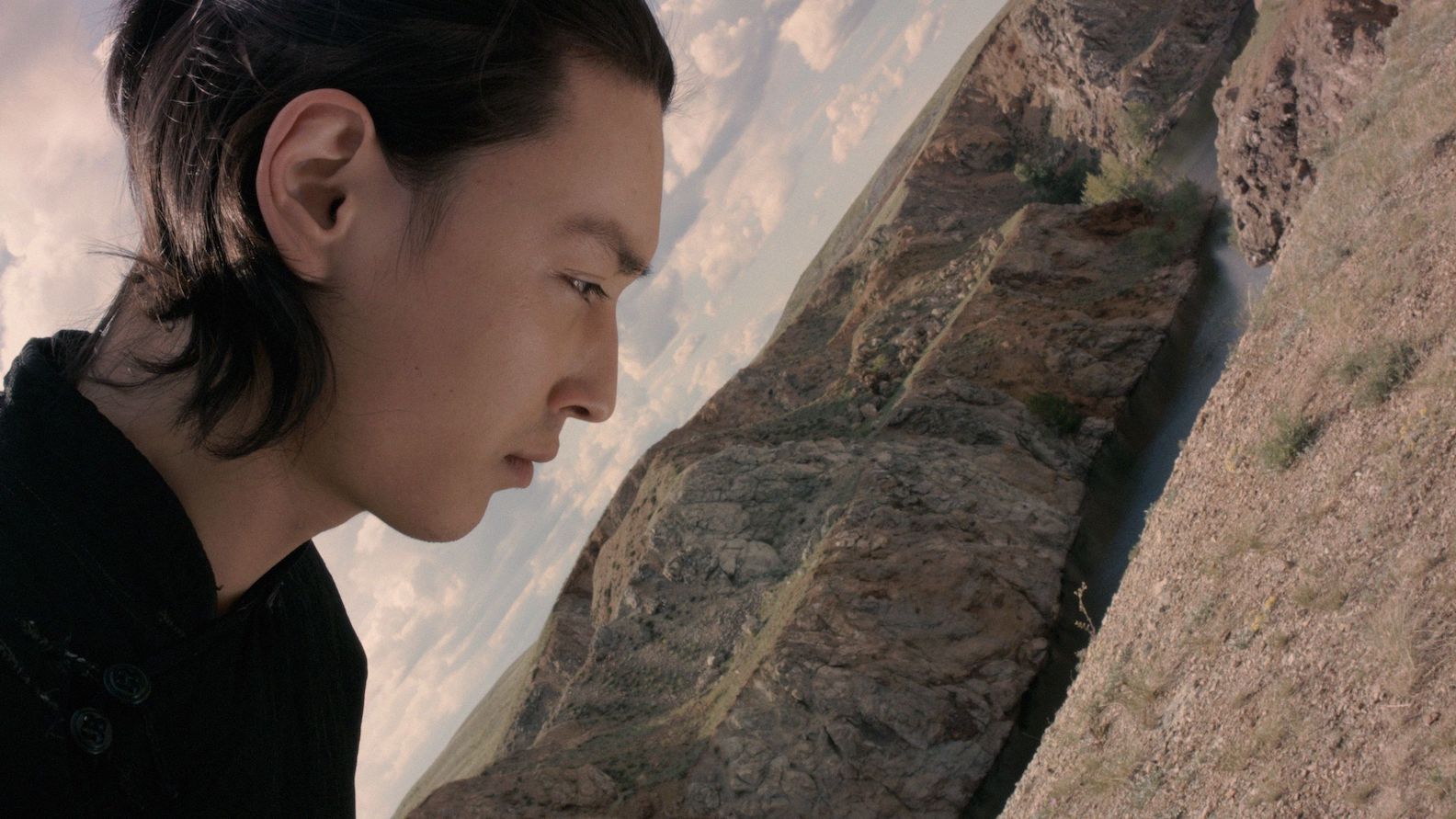
William Alderwick: What was the original idea or thought behind Eurasia?
Metahaven: There were actually several starting points. One was that after two fiction films consisting of cinematic footage and animations (Information Skies and Hometown) we wanted to return to work which contained a documentary element – as in The Sprawl: Propaganda about Propaganda). We also wanted to bring humor and playfulness to this new work.
We were very interested in the New Silk Road, an economic and somehow also political infrastructure being created between China, Russia, Africa, and Europe. The New Silk Road (or Belt and Road Initiative as it’s officially called) is partially a new infrastructure, though one that is re-using or appropriating an existing one, and partially a geopolitical concept to do with the rise of China. We were also interested in the interplay between this idea, and the general political currents running through Europe right now, which seem to want to go back to a nation-state past that never properly existed. The disintegration of the common European post-war space runs in parallel with the advance of geopolitical currents away from the trans-Atlantic. At the same time, in Russia, a certain obsession with the East has always existed, and is on increasingly tense terms with the equally strong tendency that defines Russia as “European.” These unresolved threads form part of Eurasia, though not in a straightforward manner.
So how does the film relate back to The Sprawl: Propaganda about Propaganda?
Of course the work ended up being very different, but there are connections. For instance, there are elements of documentary or reporting featured, although not through talking heads as in The Sprawl. We were keen to stay away from talking heads as a voice and image of authority. They’re also linked in that they speak of an incredibly large structure. In The Sprawl this was the megastructure of technology and the Stack. In Eurasia it’s territory, or landmass. It became a much more absurd film and a much more poetic film than The Sprawl. The role of poetry was much bigger – the idea was that eventually the ability to make sense of things is lost.
There are moments of laugh out loud humor in the film – certainly with the character who is passionately talking about changing the world with novelty plastic drinking straws. Then there’s also something quite comic about the keytar music video sequence near the end. Was there a critique of yourself and your own aesthetic in there as well?
Absolutely – although the thing about the straws guy is that we actually take him very seriously! On some level, we see what he says about straws as similar to our take on graphic design. Like, what more can a straw do than be something to drink through? He talks about a surplus value that’s somehow in this object, while recognizing that the object is also, at the same time, quite insignificant. And the drinking straw lends itself also to becoming this metaphor for trees, pipeline, connectors, and infrastructure. It’s very visual. Like an icon, like pop culture. But it seems he’s almost projecting an entire universe into the question of a straw.
How is the New Silk Road changing the world?
It was important to us to try and find actual pieces of this New Silk Road. The scale of the infrastructure that’s being built is enormous, and there’s a lot of promotion. Going to the actual geographical borderline of Asia and Europe, we tried to see if there was actually anything there. There is a shot in the film of a train arriving with wood on it which we think is near the original route. But we also found that different parts of this infrastructure may not be completely in place. We think it’s already a kind of psychological operation. The idea itself is already extremely effective.
What are the questions on happiness in Eurasia’s subtitle?
There was a lot of debate about this subtitle. For us it is connected to one specific scene in which you see the steppes. This series of long shots of vast spaces and skies that slowly fade into each other. It’s an almost spiritual scene.
There’s a poem in this film, “Silentium” by Fyodor Tyutchev. It’s very lyrical. He talks about silence – and in a sense the Eurasian landmass appears as a thing that is so enormous that it silences. It becomes this pillow or blanket in which you land. That’s very much the scene in the steppes. Maybe there is some weird sense of that being an antidote to saturation or to the idea of bubbles, but it’s difficult to see this as the film going zen because clearly it cannot go there completely. It is something that only exists in the film because it contrasts with something else.
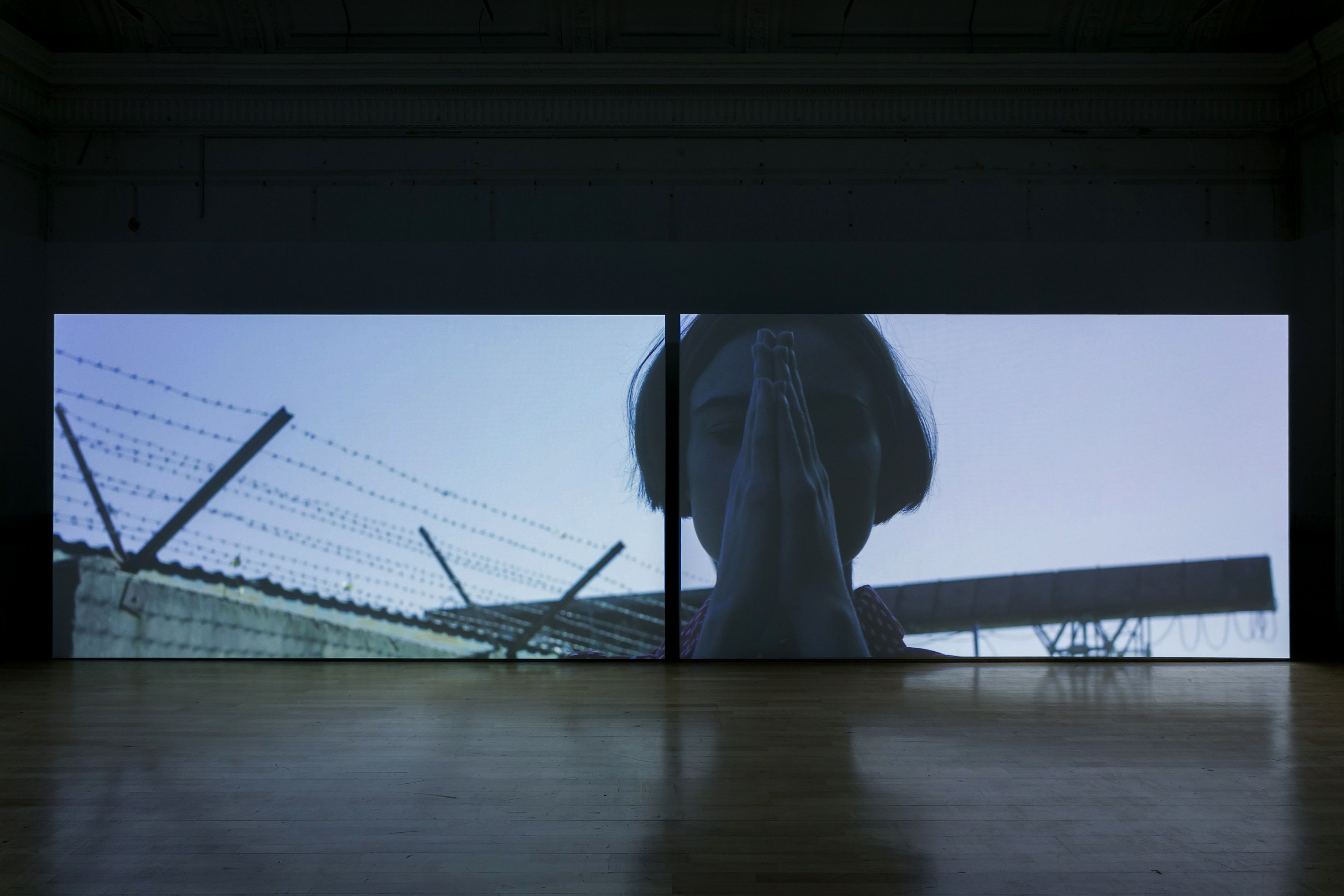
Is it a return to nature perhaps? Perhaps a nature that has become a sentient environment, a post-AI digital landscape?
AI nature – yeah! One thing that’s in this film is the notion that the reality AI produces does not explain itself to human beings. That’s something that it has in common with nature. It doesn’t want to proclaim, in our view at least, a return to a romantic idea of primitivism. But it returns to a sense of being in an environment that operates without a self-explanation, or it operates without bearing legitimacy on an underlying philosophical or ideological order.
I wanted to ask about the texture of the film, different stocks, cinematic, iPhone, or found footage as a visual method. How does this relate to its layering, not just sequentially one texture and another, but also with animations and interface elements?
Digital film is a patchwork of all possible textures. The short animations are the film that is fictionalizing itself. We have a fictional protagonist, Ilya, who is being re-fictionalized by dreaming activities he doesn’t do. He’s driving a motorcycle with his eyes closed. And that never happened. But we can imagine it and therefore it did happen – to some extent.
You started in graphic design and now produce artistic films, how do you see your role, artistically, creatively, given that you operate outside a traditional art context?
Ever since we started producing moving image works, which was in 2015, we have referred to ourselves as a collective, even though we’re just two people. It gestures to the collective nature of the productions and the relationships we build through them. We still produce design, and in addition to working in film and video we write, and produce installations and textile works.
We’re interested to see how the complexities of the now can be presented and narrated, but not in such a way that we end up at a conclusion and judgement of it – but rather, a feeling of it. Through this form of work — a combination of fiction, poetry, documentary, music, installation, environment, duration, image making, and storytelling, all mixed together — we hope to provide an insight for viewers so they might not judge, or at least postpone a their instinctive assessment.
Reading Black Transparency, it struck me that with your graphic work there was a real concern to connect emotionally with your audience through design. Is that what you’re talking about now? The affective space of propaganda? Certainly, with Hometown and Information Skies, they’re not films in which you are told a story, they’re films in which you feel a story.
We’re happy that you talk about “feeling a story.” We need to find out what that means, of course. We shot Hometown partially in Beirut. Lebanon has a power cut every day for three hours to recharge the power grid. Someone made an app so that you know when the power cut is scheduled. That person is not connected in any way to the people who organize the power cuts, so there is a sense of lurking chaos underneath reality. It’s a place of deep uncertainty, and the type of life that’s engendered by the certainty of the uncertainty is very close to what inspired the film.
The postponement of a judgement of a situation is itself an experience that can lead to new connections. And those are the connections that we wish to engender and those are also connections that have to do with poetry. That have to do with the narration of bonds between people, childhood, and also the irrational limits that every life has. Even the protagonists of Information Skies try to make the best of it within their means – which are largely VR related.
What can you tell us about the source for the 3D-rendered war video game footage in Eurasia?
S.T.A.L.K.E.R. (Shadow of Chernobyl) is a Ukrainian first person shooter game. In these fragments, the guy lying on the ground is the protagonist from Tarkovsky’s Stalker making a brief cameo appearance. The point of the section was not the footage itself, but the seamless cut between our own footage and the game.
Do you think there was something qualitatively different about the time of the Trump campaign and the Brexit vote – that people could feel something in the air while being subjected to an intensive propaganda campaign?
The problem with platforms begins with the presumption of a human user. It begins with its non-confrontational and agreeable reduction of the world to bland human terms, with human-like avatars and seemingly positive words like “friend” or “follow.” Had platforms been more honest about their core competence – which is, organizing and stack economic operations by connecting addressable but not necessarily human entities – there wouldn’t have been all these problems, or at least, there might have been less of them. Platforms “humanized” before humans could “platformize” – before we could develop the necessary digital literacy to work through the cognitive challenges that they bring.
The problem with fake news is not that it’s fake but that the human user assumes that it is for them. That is, the human user assumes that the constitutive dimension of language, as in, defining real things in a real world, still applies when they are viewing fake news. If you think about it, this is a bit like an inverse Turing test. Instead of a computer probing to ascertain that they’re dealing with a human being, a human being is somehow trying to ascertain that they are not dealing with a computer – and for a computer, the constitutive weight of words like “European Union,” “immigration,” and “the NHS,” is and always was null and void.
The indifference of microchips and computational hardware and software to the constitutive meaning of words outside the operating system implies that there is more of this to come. Teaching “ethics” to an AI would, among other things, come down to constructing a learning process between the consequential weightlessness of words inside the AI’s brain and the constitutive meaning of these same words in the brains and realities of others, even if this meaning is itself also a fallacy of sorts, when you think about it.
The Berlin-based poet and translator Eugene Ostashevsky is adamant about the capacity of poetry to demonstrate the fallacy of the constitutive dimension of language (in his passionate defense of Russian poets such as Daniil Kharms and Alexander Vvedensky). In an interview in our recent book PSYOP (2018), Ostashevsky mentions Francois Rabelais, whose Gargantua and Pantagruel was widely read by kids in Russia, and Mikhail Bakhtin, a Russian literary philosopher, who developed the idea of heteroglossia – the idea that the novel is “the place where idiolects, sociolects, and even other languages collide.”
Is post-truth as a state something that is escapable? How do we respond to it? I think specifically my major question is how do you actually build collective activism and unity if you don’t have any epistemic shared ground?
The film hints at the idea that post-truth is a test of our cognitive bias. It’s a human approximation of what an AI would probably feel about their own condition. It would be nothing, it would not be empathetic to our cognitive flaws, which cause us to believe in fake reports, fake news, and so on. There’s one element of it that is a precursor to how AI could fundamentally twist our cognition. The things that make us believe a story are the parts of our cognition that can be easily messed with. It’s not enough to say we have to purge our media of anything that’s not true, or that’s not tested. There’s a question we need to ask ourselves about deep learning and pattern recognition, a reboot of what used to be called media literacy. We carry with us our old sense of cognition into an era that exposes how our language is fundamentally, constitutively empty. What we need is an evolution of cognition.
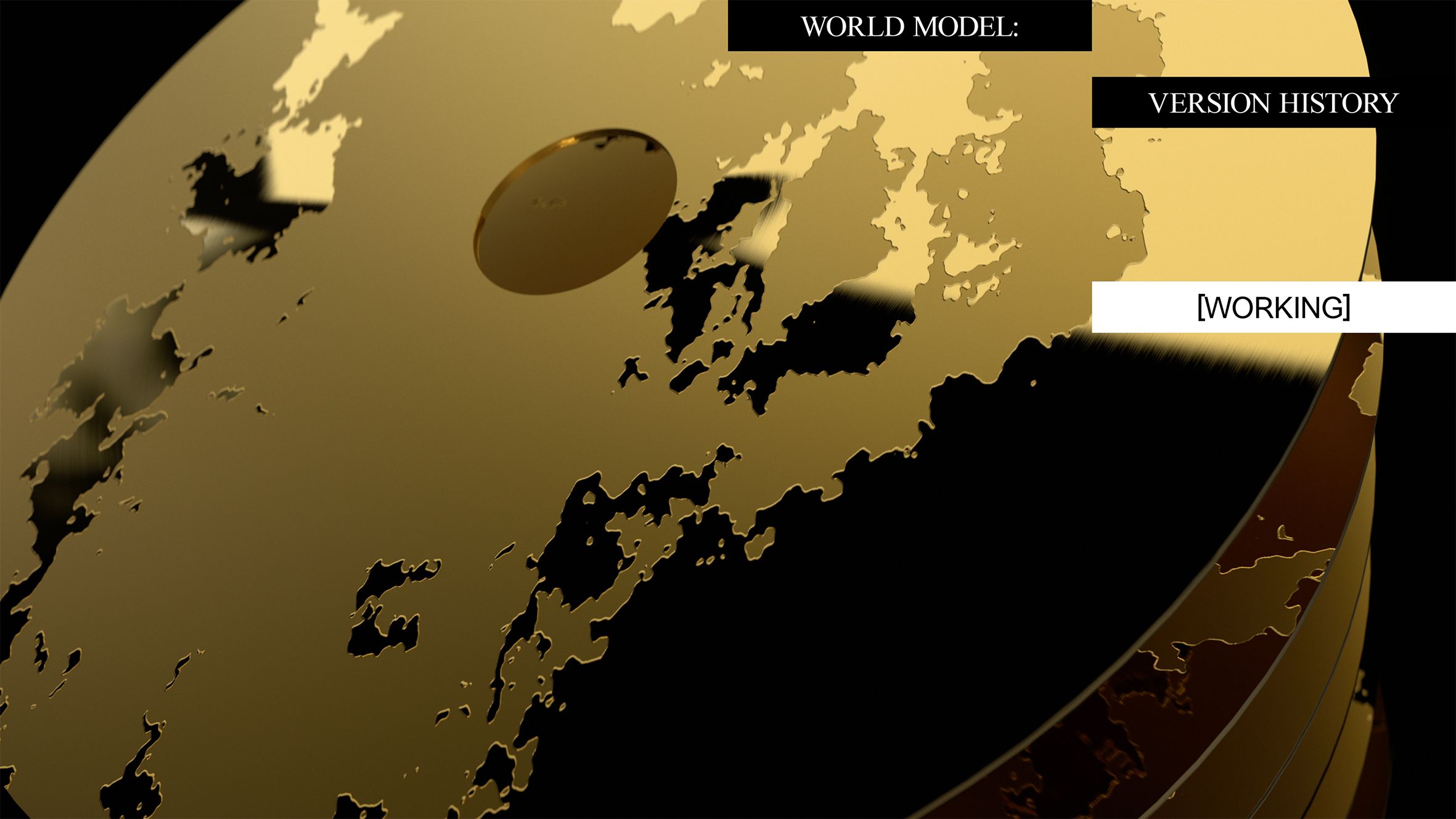
Credits
- Text: William Alderwick
- Film stills: Metahaven
- Installation photography: Mark Blower and the ICA, London
